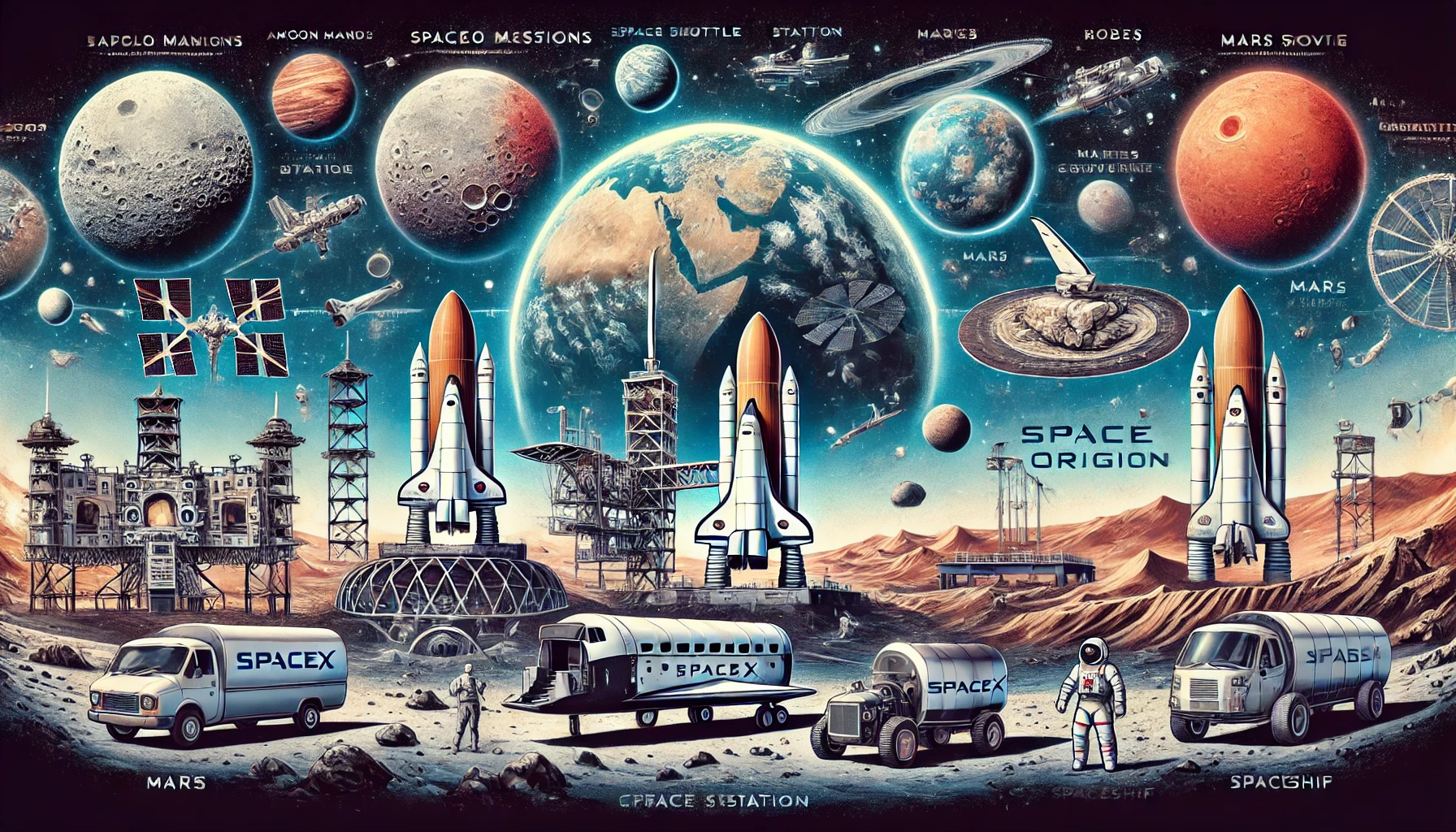The Fascination with the Heavens: Humanity’s Ongoing Journey Beyond Earth Humanity’s yearning to reach beyond our planet reflects our deep-seated desires for discovery, bold undertakings, and the mysteries that lie in the cosmos. From the momentous Apollo voyages that sent the first Earthlings to the Moon’s surface to the bold blueprints for settling humans on Mars, the field of cosmic travel has seen extraordinary advancements. We will explore the chronicles of this journey and cast our eyes toward the thrilling prospects that await.
The Inception of Cosmic Voyages The latter half of the 20th century heralded the advent of the era of space exploration, fueled by both the competitive spirit of nations and the pursuit of scientific knowledge.
- The Competition in Space
Sputnik 1: The Soviet Union made history on October 4, 1957, by sending Sputnik 1 into orbit around our planet, inaugurating the competitive race to space between the United States and the Soviets. Yuri Gagarin: On April 12, 1961, the Soviet Union’s Yuri Gagarin ventured into space aboard Vostok 1, marking the first time a human orbited our planet. His journey confirmed that space travel was within human capabilities.
- The Moon-landing Endeavor
NASA’s Apollo initiative, launched in the 1960s, was dedicated to achieving the milestone of landing humans on the Moon and ensuring their safe return.
Apollo 11: Astronauts Neil Armstrong and Edwin “Buzz” Aldrin landed on the Moon on July 20, 1969, as part of Apollo 11, while Michael Collins orbited above. Armstrong’s iconic statement, “That’s one small step for man, one giant leap for mankind,” encapsulated this tremendous feat. Further Lunar Journeys: Apollo 12 to 17 missions expanded lunar investigations, gathering precious scientific knowledge and specimens. The final crewed lunar mission was Apollo 17 in 1972.
Progress in Space Engineering and Discovery Post-Apollo, space exploration continued to thrive, with innovation in technology and collaborative international efforts.
- The Space Shuttle Project
Reutilizable Vessels: With the inauguration of NASA’s Space Shuttle program in 1981, vessels that could be used multiple times became a reality, enabling the transport of crew and supplies to and from Earth’s orbit. The shuttle fleet contributed significantly to the construction and upkeep of the International Space Station (ISS).
- The International Space Station
Alliance in Space: The ISS, established in 1998 through the partnership of space agencies including NASA, Roscosmos, ESA, JAXA, and CSA, operates as a zero-gravity scientific lab, a hub for technological progress, and a model for international cooperation.
- Unmanned Space Missions
Martian Rovers: NASA’s rovers, such as Spirit, Opportunity, Curiosity, and Perseverance, have unveiled critical information about Mars’ terrain, climate, and its potential to have once harbored life. Hubble Space Telescope: Since its launch in 1990, the Hubble Space Telescope has provided breathtaking celestial images, deepening our grasp of the universe’s structure and evolution.
The Contemporary Space Epoch: Private Space Ventures and More The dawn of the 21st century has introduced a new chapter in space exploration, marked by the emergence of commercial space endeavors and ambitious deep space projects.
- Commercial Space Ventures
SpaceX: Elon Musk’s SpaceX has altered the landscape of space voyages with the Falcon launch vehicles and Dragon space capsules. In 2020, SpaceX’s Crew Dragon ferried astronauts to the ISS, representing the inaugural commercial crewed spaceflight. Blue Origin: Jeff Bezos’ Blue Origin aspires to democratize space travel, crafting recyclable rockets like New Shepard for suborbital journeys and New Glenn for orbital missions. Virgin Galactic: Spearheaded by Richard Branson, Virgin Galactic is concentrating on suborbital space tourism, providing travelers with ephemeral experiences of weightlessness and spectacular terrestrial vistas.
- The Lunar Return
Artemis Program: NASA’s Artemis initiative is set to bring humans back to the lunar surface by the 2020s mid-decade, aiming to establish a lasting foothold and utilizing the Moon as a launching pad for Mars expeditions. Artemis I, an unmanned trial mission, launched successfully in 2022.
The Horizons of Space Exploration: Mars and Further As we look to the future, both governmental space entities and private firms are eyeing the colonization of Mars and additional ventures into the depths of space.
- Mars Settlement
SpaceX’s Starship: Under the vision of Elon Musk, SpaceX is crafting the Starship, intended for extended cosmic journeys and the establishment of a human settlement on Mars. Musk’s goal is to create a self-reliant community on the Red Planet within the upcoming decades. NASA’s Martian Projects: The 2020-launched Perseverance rover forms part of a larger scheme to lay the groundwork for human excursions to Mars. Its objectives include the hunt for evidence of ancient life and the collection of materials to be sent back to Earth.
- Global and Private Sector Efforts
China’s Cosmic Aspirations: China has forged ahead in space exploration with projects like the Chang’e moon missions and the Tianwen-1 Martian endeavor. It seeks to build a lunar research outpost and undertake crewed Martian missions. Mars-centric Groups: Associations such as the Mars Society and Mars One are championing and orchestrating human journeys to Mars, emphasizing research, technological innovation, and engaging the public.
- Interstellar Voyages
James Webb Space Telescope: Slated for a December 2021 launch, the James Webb Space Telescope will probe the universe’s ancient galaxies, stellar birthplaces, and distant planets, furthering our comprehension of cosmic beginnings. Probes to the Stars: Initiatives like Breakthrough Starshot are conceptualizing the dispatch of diminutive, light probes to Alpha Centauri, the closest star system, using beams of light for propulsion.
In Conclusion The saga of space exploration stands as a tribute to human creativity, perseverance, and the intrinsic drive to delve into the uncharted. From the trailblazing Apollo missions to the grand visions for setting down roots on Mars, space exploration has persistently expanded the horizons of what humanity can achieve. With technological advancements and enhanced global cooperation, the prospects of space exploration hold the promise of even more groundbreaking revelations and the potential for humanity to evolve into a species that resides across multiple celestial bodies.
